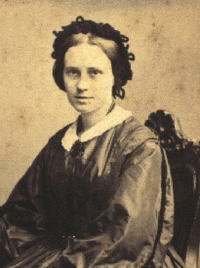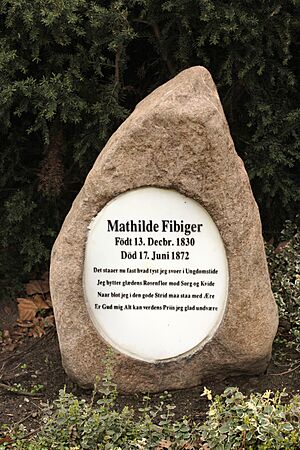Mathilde Fibiger facts for kids
Quick facts for kids
Mathilde Fibiger
|
|
|---|---|

Mathilde Fibiger, photographed by Thora Hallager
|
|
| Born | 13 December 1830 Copenhagen, Denmark
|
| Died | 17 June 1872 (aged 41) Aarhus, Denmark
|
| Nationality | Danish |
| Occupation | Writer, suffragist |
Mathilde Fibiger (born December 13, 1830 – died June 17, 1872) was a Danish writer and a pioneer for women's rights. She also became one of the first women to work as a telegraph operator.
Contents
Early Life and Family
Mathilde Fibiger was born in Copenhagen, Denmark, in 1830. Her father, Johan Adolph Fibiger, was an army officer. Her mother was Margrethe Cecilia Nielsen Aasen. Mathilde also had an older sister named Ilia Fibiger.
Mathilde Fibiger: A Champion for Women's Rights
Mathilde Fibiger was a novelist who strongly supported women's rights. She became the first public figure in Denmark to speak out about this important issue. She wrote novels, articles, and discussion papers starting at age 20 in 1851.
Her First Book: Clara Raphael
Her first novel, "Clara Raphael, Tolv Breve" (Clara Raphael, Twelve Letters), was published in 1851. This book was partly based on her own life. It tells the story of a young woman, Clara Raphael, who works as a governess. Clara's ideas about women living independent lives were very different from what people believed at the time. She decided to make women's freedom her main goal in life.
The book caused a lot of discussion when it came out. Some people supported her ideas, while others thought they were too new and radical. However, everyone agreed that her writing was very good.
Standing Up for Women's Equality
To answer people who disagreed with her ideas about women's rights, Mathilde Fibiger published two short books. These were called "Hvad er Emancipation?" (What is Emancipation?) and "Et Besøg" (A Visit).
She also wrote other novels. These included "En Skizze efter det virkelige Liv" (A Sketch from Real Life, 1853) and "Minona. En Fortaelling" (Minona: A Tale, 1854). "Minona" caused new discussions because it included a complex story about unmarried mothers.
Pioneering Work as a Telegraph Operator
Even though Mathilde Fibiger's novels were praised by critics, they did not sell many copies. She needed to find other ways to support herself. She received a small amount of money from the state. She also made dresses and translated German books.
Becoming Denmark's First Female Telegraphist
In 1863, she started training to be a telegraph operator. The Danish State Telegraph service had recently decided to hire women. This decision was made under the manager Peter Faber.
In 1866, Mathilde finished her training at the Helsingør telegraph station. She then became the first woman to be hired as a telegraph operator in Denmark. This was a very important step for women in the workplace.
Challenges and Legacy
After working for two years in Helsingør, she moved to Nysted in 1869. There, she managed a new telegraph station. It was not easy for her. Some male operators did not like women working in these jobs. They worried it would affect their own work. Even though she was a manager, her pay in Nysted was barely enough to cover her living costs.
The next year, she asked to move to the telegraph station in Aarhus. She continued to face difficulties there. The station manager in Aarhus had not wanted her to be assigned there. The problems she faced at work started to affect her health. Mathilde Fibiger died in Aarhus in 1872 when she was 41 years old.
Today, Mathilde Fibiger is remembered in Denmark for two main reasons. She was a pioneering woman who wrote to support women's rights. She also opened the door for other women to work in the Danish State Telegraph service.
Honoring Her Contributions
Mathilde Fibiger was a very important advocate for gender equality. To honor her work, the Dansk Kvindesamfund (Danish Women's Society) created "Mathildeprisen" (The Mathilde Prize).
The Mathilde Prize
The Mathilde Prize was started in 1970. It is given to both men and women who have worked to advance gender equality. Some people who have received this prize include Suzanne Brøgger, Joan-søstrene, Kenneth Reinicke, Anja Andersen, and Anja C. Andersen.
Places Named After Her
A street in Frederiksberg, Copenhagen, is named "Mathilde Fibigers Vej" after her. A small garden square next to the Women's Museum in central Aarhus is also named "Mathilde Fibigers Have" in her honor.
The building of Kvindernes Boligforening (Women's Housing Association) at Østerbrogade 85 in Copenhagen is called Clara Raphaels Hus. This name honors Fibiger's famous novel, Clara Raphael.


